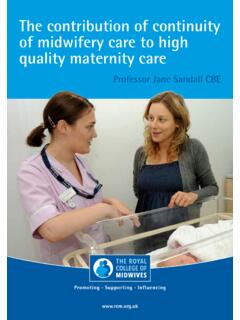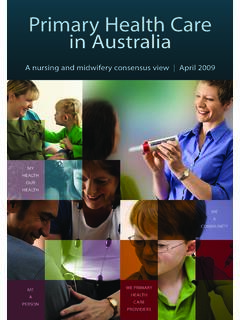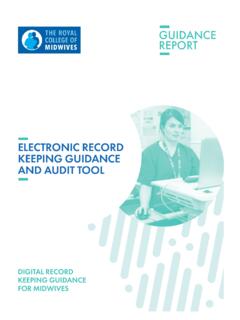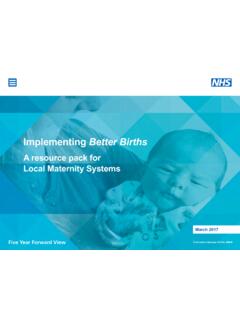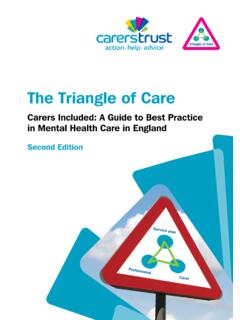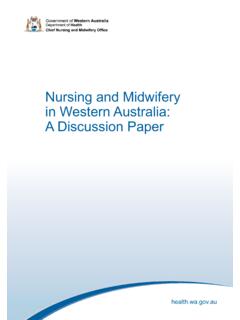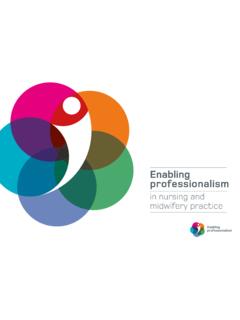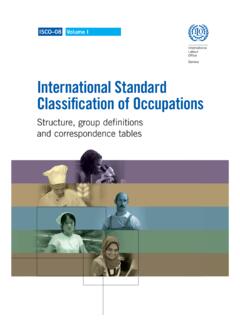Transcription of Delivering expectations - GOV.UK
1 Delivering expectations midwifery 2020: Delivering expectations Rona McCandlish Chief Nursing Officer s Directorate Professional Leadership Team Department of Health Location 452C Skipton House 80 London Road London SE1 6LH 020 972 6522 4 midwifery 2020: Delivering expectations Contents Foreword from the Chief Nursing Officers of England, Northern Ireland, Scotland and Wales 2 Introduction and key messages 1 midwifery 2020: Delivering expectations for the future 11 2 Working towards midwifery 2020 13 3 The context of midwifery 2020 15 Health and social context Economic context The workforce Context of midwifery practice Midwives as part of the multidisciplinary team Changes in midwifery education Careers in midwifery Summary 4 Enabling midwives to make the difference 21 Meeting women s needs The midwifery workforce Developing the midwife s role in public health and addressing inequalities Measuring the contribution midwives make Supporting midwives Developing a contemporary image of midwifery Educating midwives Developing midwives Maximising midwives influence 5 Delivering expectations 43 References Appendices Appendix 1 Membership of the UK Programme
2 Board Appendix 2 Membership of the national steering groups and five workstreams 49 Appendix 3 Analysis of political, economic, social and technological change: a vision for the future 54 1 16 17 18 18 18 19 20 20 22 25 26 28 31 33 34 36 38 47 49 49 midwifery 2020: Delivering expectations Foreword From the Chief Nursing Officers of England, Northern Ireland, Scotland and Wales Midwives and the care they provide to women, babies and families are of the utmost importance to society. Across the United Kingdom midwives are key professionals in ensuring that women have a safe and emotionally satisfying experience during their pregnancy, childbirth and postnatal period. The coming decade will present new challenges and opportunities for midwives to develop further their role as practitioners, partners and leaders in Delivering and shaping maternity services.
3 We commissioned midwifery 2020 to develop a vision of midwifery so that midwives across the UK can fulfil women s health and social needs and expectations . Our aim was to consolidate the achievements that midwifery has made and to identify changes needed to the ways midwives work, their role, responsibilities, and the education, training and professional development needed to achieve these outcomes. The principal objectives of midwifery 2020 have been to: Review the current and developing role of midwives in the UK within the context of evolving healthcare provision, tackling inequalities, improved outcomes, and user expectations and experiences Gather and use available evidence to set the appropriate direction for midwifery services across each of the UK countries Use national and international evidence, taking account of factors which will influence the landscape, to scope and describe current and potential models of midwifery service provision Scope current midwifery education and consider its fitness for purpose Identify current and future career pathways for midwives Maximise the potential for midwives to develop capacity and capability in developing and Delivering research-based practice Scope the role.
4 Capabilities and career pathway for maternity support workers/maternity care assistants in supporting midwives, midwifery practice and maternity care Consider opportunities and ways of supporting and retaining midwives in practice. midwifery 2020 has been a unique UK-wide collaborative programme with the full and active involvement of the four UK Chief Nursing Officers in England, Northern Ireland, Scotland and Wales and carried out in partnership with the Royal Colleges, the Nursing and midwifery Council (NMC), and with diverse partners and stakeholders in maternity 2 The work of midwifery 2020 political, legal, economic, social and technological changes facing the UK. that impact on midwifery and maternity services. central to midwifery 2020 identify priorities for each country. our prime concern. midwifery 2020) Llywodraeth Cynulliad Cymru Dame Christine Beasley, DBE Department of Health England Martin Bradley Department of Health, Social Services and Public Safety The Scottish Government Scotland 3 midwifery 2020: Delivering expectations care , professional bodies, higher education, user organisations, employers and commissioners of service and education across all four countries.
5 Has been set firmly within the reality of the There are undoubtedly challenges in developing a vision and way forward for midwifery care across the four countries of the UK because of the different ways in which services are organised and the policies There are, however, many similarities and the key messages that are provide, we believe, a robust and far-reaching vision of the future for midwifery against which all four countries can benchmark their midwifery planning and provision to We charge all those involved in Delivering expectations for midwifery and maternity services to actively review our key messages and to transform their services for the women, babies and families who are Rosemary Kennedy, CBE (Chair, Chief Nursing Officer Welsh Assembly Government Chief Nursing Officer Chief Nursing Officer Northern Ireland Ros Moore Chief Nursing Officer midwifery 2020: Delivering expectations Introduction midwifery 2020 has set out to develop an informed vision (opposite) of the contribution midwives will make to achieving quality, cost-effective maternity services for women, babies and families across the United Kingdom.)
6 Midwives, managers, members of the maternity team, educationalists, commissioners and service users considered the future direction for midwifery and this report brings together the outcomes of their deliberations. It is supported by five in-depth workstream reports that are available on the midwifery 2020 website at We have set out below our key messages resulting from the work of the midwifery 2020 programme which underpin the vision of how midwives can lead and deliver care in a changing environment. They reinforce and restate the core values of the profession, celebrate the achievements made in the past, and show how midwives can continue to strengthen their unique contribution as key professionals who ensure that women, their partners and their babies have safe and life enhancing experiences. The key messages are addressed to all those with an involvement in midwifery and maternity services.
7 How you use the report and its key messages will depend on your role and we urge you to consider what you can do to ensure that midwives can maximise their contribution to Delivering quality services for women, babies and families. 4 5 Our vision of midwifery in 2020 Midwives will continue to be members of a highly skilled workforce with the scope to provide world-class maternity care from the provision of direct care through to Board level contributions . Midwives will be the lead professional for all healthy women with straightforward pregnancies. For women with complex pregnancies they will work as the key coordinator of care within the multidisciplinary team, liaising closely with obstetricians, general practitioners, health visitors/public health practitioners and maternity support workers/maternity care assistants.
8 And social care contexts. They will have the capacity to initiate and to respond to change. Midwives will embrace a greater public health role. Individual midwives and the midwifery workforce will expect support from those who plan and commission maternity services to enable them to meet the challenges of reducing inequalities and improving maternal and family health. Holistic models of care will be delivered by a graduate professional who makes autonomous decisions will have a trusting relationship with a midwife, or small team of midwives, who coordinate her care and provide continuity of care throughout pregnancy and the postnatal period. Midwives will continue to provide the majority of care to pregnant women and therefore will maintain and develop their competence and will be champions of care in the hospital and community.
9 Increased focus on social models of care with women and families' needs at the very heart of midwifery and maternity care . There will be an increased focus on measuring the quality of healthcare across the whole maternity equity and timeliness. midwifery education will be rooted in normality whilst preparing midwives to care for all women including those with complex medical, obstetric and social needs. It will prepare and develop midwives to be skilled and safe, empathic and trustworthy with increased emphasis on the principles of autonomy and accountability within multidisciplinary and multi-agency teams. All midwives will recognise that their learning continues after graduation. They will have access to education. roles in service delivery at Board level, for example Director of Nursing and midwifery , Director of Maternity Services, or Director of Public Health.
10 midwifery will be seen as a positive career choice with a range of rewarding career pathways. Careers advisors will promote midwifery and be aware of the full range of career opportunities available to midwives, including those in research. Clinical academic careers for midwives will be promoted to enable the midwifery profession to better engage in the collaborative research agenda. midwifery 2020: Delivering expectations Midwives will deliver innovative evidence-based, cost-effective, quality care across integrated health when appropriate, consults where necessary and manages a woman s health and social needs. A woman Responding to women s experiences of care will drive quality improvement and this will result in an pathway. The best indicators of quality will reflect: person centredness, safety, effectiveness, efficiency, relevant, timely continuing professional education and will have sufficient time to take part in this Midwives will be part of a culture in which they are respected, aspire to, and are prepared for, strategic midwifery 2020: Delivering expectations Key messages Meeting women s needs Women and their partners want a safe transition to parenthood and they want the experience to be positive and life enhancing.










